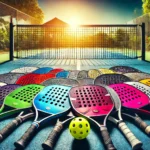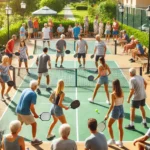Complete Guide to Pickleball Rules and Gameplay (2025 Update)
Pickleball is one of the fastest-growing sports worldwide, combining elements of tennis, badminton, and table tennis into a fun and accessible game. Whether you’re a beginner or an experienced player, understanding the official rules is essential to enjoying the game and competing at a high level.
In this comprehensive guide, we’ll cover everything you need to know about pickleball rules, including gameplay mechanics, scoring, faults, serving techniques, and the latest updates for 2025.
Introduction to Pickleball
Pickleball was invented in 1965 as a backyard game but has since evolved into a competitive sport with official governing bodies, including USA Pickleball (USAP) and the International Federation of Pickleball (IFP). The game is played on a court similar in size to a badminton court and can be enjoyed in singles or doubles formats.
The sport is accessible to players of all ages due to its small court size, slower-moving ball, and relatively simple rules. However, at competitive levels, pickleball requires a high level of skill, strategy, and fitness.
Basic Pickleball Court Layout
A pickleball court measures 20 feet wide and 44 feet long, divided into the following key areas:
- Baselines – The back lines of the court.
- Sidelines – The side boundaries of the court.
- Service Areas – Two 10-foot-wide boxes on each side, divided by the centerline.
- Non-Volley Zone (NVZ) or “The Kitchen” – A 7-foot area on both sides of the net where volleying (hitting the ball before it bounces) is prohibited.
- Net – Positioned at 36 inches high at the sidelines and 34 inches high in the center.

Pickleball Serving Rules
1. How to Serve in Pickleball
- The serve must be underhand, with the paddle making contact below the server’s waist.
- The server must stand behind the baseline and serve diagonally into the opponent’s service box.
- The ball must clear the non-volley zone (kitchen) and land within the diagonal service box.
- Only one serve attempt is allowed per point (except in the case of a let serve).
2. Serving Sequence in Singles and Doubles
Singles Serving
- The server continues serving as long as they win points.
- When the server loses a rally, the opponent takes over the serve.
Doubles Serving
- Both teammates get a chance to serve before the opposing team gets a turn (except for the first serve of the game).
- After a fault, the serve switches to the second server in the team.
- When both players in a team lose their serve, the opposing team gets to serve.
The Two-Bounce Rule
One of the most important rules in pickleball is the two-bounce rule, which states:
- The receiving team must let the serve bounce once before returning it.
- The serving team must also let the return bounce once before hitting it back.
- After these two bounces, players may volley (hit the ball in the air) or continue playing off bounces.
This rule prevents immediate net smashes and promotes longer rallies.
The Non-Volley Zone (Kitchen) Rule
The non-volley zone (NVZ), or “the kitchen,” is a crucial part of the game. It extends 7 feet from the net on both sides and has strict rules:
- Volleying (hitting the ball in the air) is not allowed while standing inside the kitchen.
- Players can enter the kitchen only after the ball has bounced.
- If a player’s foot is inside the NVZ while volleying, it results in a fault.
- The kitchen rule prevents players from dominating the net with smashes.
Pickleball Scoring Rules
1. How to Score Points
- Only the serving team can score points in pickleball.
- A point is awarded when the opponent makes a fault (e.g., missing a shot, hitting out, stepping into the kitchen on a volley).
2. Winning the Game
- Most games are played to 11 points, and a team must win by at least 2 points.
- In tournaments, matches may go to 15 or 21 points, still requiring a 2-point lead.
3. Calling the Score
- In singles, the server announces their own score first, followed by the opponent’s score (e.g., “5-3”).
- In doubles, the call includes the server number (e.g., “7-4-1” means server 1 is serving with a score of 7-4).
Pickleball Faults and Rule Violations
A fault results in a point for the opponent or loss of serve. Common faults include:
- Serving faults – Serving into the net or out of bounds.
- Volleying in the kitchen – Hitting the ball out of the air while inside the non-volley zone.
- Double bounces – Hitting the ball before it bounces once on each side after the serve.
- Hitting out of bounds – The ball lands outside the court boundaries.
- Net faults – Touching the net or hitting the ball into the net.
Recent Rule Changes for 2025
Each year, USA Pickleball updates its official rulebook. Here are some key updates for 2025:
- Clarifications on the spin serve: Excessive spin serves are now restricted to promote fair play.
- Timeout adjustments: Players now have shorter timeouts in competitive matches.
- Updated paddle regulations: Paddle specifications have been revised to prevent performance-enhancing materials.
For full details, check the official USA Pickleball rulebook.
Pickleball Strategy Tips
- Master the Soft Game – Use dinks (soft shots over the net) to control play and force errors.
- Dominate the Kitchen Line – Stay near the non-volley zone to block aggressive shots.
- Target Weaknesses – Hit to your opponent’s weaker side (usually the backhand).
- Communicate in Doubles – Coordinate with your partner to avoid confusion.
- Use Drop Shots Effectively – A well-placed drop shot can neutralize aggressive opponents.
Conclusion
Pickleball is an exciting, strategic, and rapidly growing sport with simple yet nuanced rules. Whether playing recreationally or competitively, understanding the rules ensures fair and enjoyable gameplay.
With USA Pickleball’s latest updates, players can expect a more balanced and skill-driven experience in 2025. If you’re serious about improving your game, mastering these rules and strategies will give you a significant edge.
Are you ready to hit the court and enjoy the game of pickleball? Let us know in the comments below!





